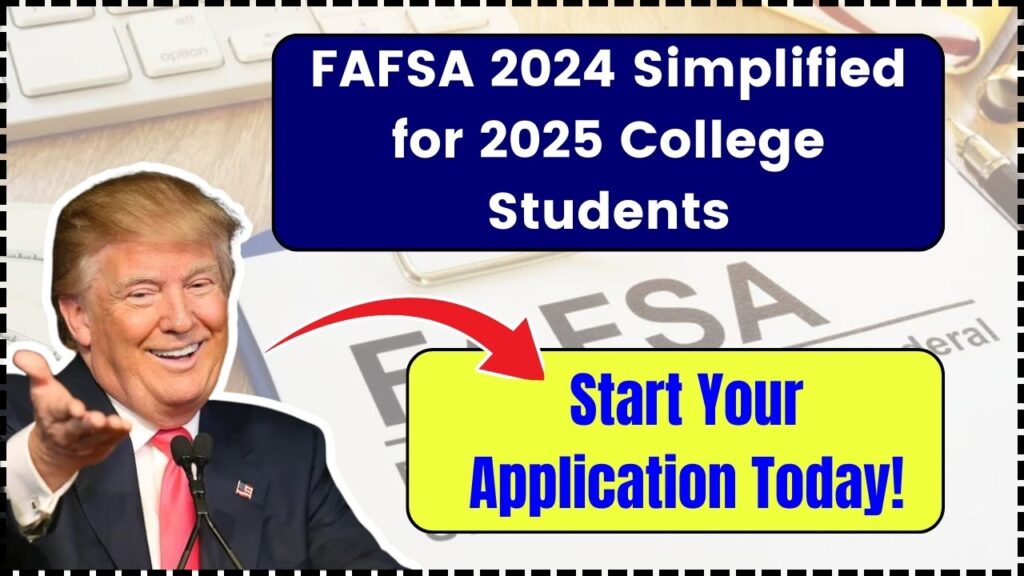FAFSA 2024 Simplified for 2025 College Students: The Free Application for Federal Student Aid (FAFSA) for the 2024-2025 academic year is now open, and it brings exciting changes that simplify the process for students and their families. Whether you’re a first-time applicant or returning to update your information, understanding these updates can help you secure the financial aid you need for college.

What is FAFSA? FAFSA is the gateway to federal grants, loans, and work-study opportunities for students. It’s also used by many states and colleges to determine eligibility for additional financial aid programs. Completing the FAFSA opens doors to a wide array of financial support, making higher education more accessible for millions of students across the country.
This article will walk you through the updated process, highlight key changes, and provide practical tips to ensure a smooth application experience. By the end, you’ll have all the tools you need to maximize your financial aid opportunities and avoid common pitfalls.
FAFSA 2024 Simplified for 2025 College Students
| Feature | Details |
|---|---|
| New Start Date | December 31, 2023 |
| Federal Deadline | June 30, 2025 |
| Major Updates | Simplified application, direct IRS data sharing, expanded Pell Grant eligibility |
| Estimated Completion Time | Less than 15 minutes for most applicants |
| Official Website | studentaid.gov |
The FAFSA is your first step toward unlocking financial aid opportunities for college. With its simplified application process and expanded eligibility criteria, applying has never been easier. Take the time to understand the process, gather your documents, and complete your application accurately.
Why FAFSA Matters
Completing the FAFSA is critical for accessing financial aid, including:
- Pell Grants: Federal grants that don’t need to be repaid, awarded to low-income students.
- Federal Student Loans: Low-interest loans with flexible repayment options.
- Work-Study Programs: Opportunities to earn money while studying.
- State and College Aid: Many states and institutions use FAFSA data to award scholarships and grants.
For example, if you qualify for a Pell Grant, you could receive up to $7,395 for the 2024-2025 academic year, depending on your financial need and enrollment status. Additionally, many states have their own grant programs, such as the California Cal Grant or the New York Tuition Assistance Program (TAP), which also rely on FAFSA data to determine eligibility.
Financial aid isn’t limited to federal programs. Many private scholarships also require FAFSA completion as part of their application process. By completing your FAFSA early, you can increase your chances of receiving aid from multiple sources.
Key Changes to FAFSA 2024
1. Simplified Application Process
The FAFSA form now has fewer questions, reducing completion time to under 15 minutes for many families. The streamlined approach eliminates unnecessary complexity while retaining the essential details needed to calculate financial aid. For families who may have been intimidated by the lengthy form in the past, this change makes the process far more approachable.
2. Direct IRS Data Sharing
Applicants can securely import tax information directly from the IRS using the IRS Data Retrieval Tool (DRT). This ensures accuracy and saves time by eliminating manual data entry. With the automatic transfer of tax data, applicants can feel confident that their financial information is precise, reducing the risk of errors that could delay aid.
3. Expanded Pell Grant Eligibility
Eligibility is now tied more closely to family size and the federal poverty level, making aid accessible to more students. Approximately 610,000 additional students will qualify for Pell Grants. This change particularly benefits larger families and those in low-income brackets, providing them with greater financial resources to pursue higher education.
4. Introduction of the Student Aid Index (SAI)
The SAI replaces the Expected Family Contribution (EFC) as a measure of financial need. Unlike the EFC, the SAI can be negative, offering greater clarity and precision in assessing aid eligibility. This shift aims to ensure that aid is distributed more equitably, especially for families with significant financial challenges.
How to Completing FAFSA
Step 1: Create Your FSA ID
An FSA ID is your secure login for completing and signing the FAFSA. Both students and parents (if applicable) need their own FSA IDs.
- Visit studentaid.gov to create your ID.
- Keep your FSA ID credentials secure, as you’ll need them every year. Write down your username and password in a safe place to avoid future login issues.
Step 2: Gather Necessary Documents
To complete the FAFSA, you’ll need:
- Social Security numbers (for students and parents).
- Federal income tax returns and W-2s from the prior-prior year (2022 for the 2024-2025 FAFSA).
- Records of untaxed income and assets.
- Your driver’s license (if applicable).
- Information about other financial investments, such as savings, stocks, or business income.
Having all these documents organized beforehand will save you time and ensure you don’t leave any important sections incomplete.
Step 3: Access the FAFSA Form
Go to studentaid.gov to start your application. Use the “Start Here” button if you’re new or “Log In” if you’re returning.
Step 4: Complete the Application
- Fill in personal information, including demographic and financial details.
- Use the IRS DRT to import tax data directly.
- List up to 10 colleges to receive your FAFSA information. If you’re considering more than 10 schools, you can log back in later to update your list.
Step 5: Review and Submit
Double-check your application for errors and omissions. Pay close attention to income figures and school codes. After submitting, you’ll receive a confirmation email with your Student Aid Report (SAR).
Your SAR summarizes the data submitted and provides an initial estimate of your eligibility for federal aid. Review this report carefully for any discrepancies.
2025 IRS Tax Bracket Updates Could Make Filing Easier—Here’s What’s New!
New $576 SSI Payments for Seniors 65+ Arrive in Just 2 Weeks – Check Eligibility
$1,400 Stimulus Payments Coming in January 2025: Are You Eligible to Get it?
FAQs About FAFSA 2024 Simplified for 2025 College Students
1. Who Should Complete the FAFSA?
All students planning to attend college in the U.S. should complete the FAFSA, even if they believe they won’t qualify for aid. Many scholarships and state grants require FAFSA data. Remember, financial aid packages can also include unsubsidized loans that don’t depend on financial need.
2. What if My Family’s Financial Situation Changed?
If your family’s income has decreased significantly since filing taxes in 2022, contact the financial aid offices of the colleges you’re applying to. They may adjust your aid package based on your current circumstances. This is known as a “professional judgment” and requires documentation to support your claim.
3. When Should I Submit My FAFSA?
Submit your FAFSA as soon as possible after it becomes available. Some aid programs have limited funds and award on a first-come, first-served basis. Early submission ensures you’re in line for state and institutional aid.
4. Can I Make Corrections After Submitting the FAFSA?
Yes, you can log in to your FAFSA account to make corrections. For example, if you entered the wrong Social Security number or need to add a new school, updates are allowed.
5. What is the Deadline for FAFSA?
The federal deadline for the 2024-2025 FAFSA is June 30, 2025. However, state and institutional deadlines may be earlier. Check with your state’s education agency and each college’s financial aid office for specific dates.
Practical Tips for a Smooth FAFSA Experience
- Start Early: Begin the application process as soon as it opens to avoid missing out on aid opportunities.
- Stay Organized: Keep all necessary documents in one place for easy access. Consider creating a checklist to track your progress.
- Seek Help if Needed: Use the FAFSA Help Center (studentaid.gov/help-center) or consult your school’s financial aid office for assistance. Many schools offer FAFSA workshops to guide students through the process.
- Avoid Errors: Common mistakes include using incorrect Social Security numbers, misreporting income, or failing to sign the form electronically. Double-check all entries before submission.
- Follow Up: After submission, monitor your email for any requests for additional information or documentation. Responding promptly can prevent delays in receiving aid.








